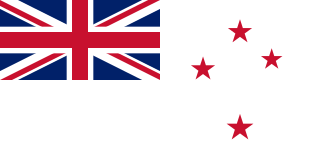
HMAS Echuca (J252/M252), named for the town of Echuca, Victoria, was one of 60 Bathurst-class corvettes constructed during World War II, and one of 36 initially manned and commissioned by the Royal Australian Navy (RAN).

HMAS Inverell, named for the town of Inverell, New South Wales, was one of 60 Bathurst-class corvettes constructed during World War II, and one of 36 initially manned and commissioned solely by the Royal Australian Navy (RAN).

The Royal New Zealand Navy is the maritime arm of the New Zealand Defence Force. The fleet currently consists of nine ships.

HMAS Kiama, named for the coastal town of Kiama, New South Wales, was one of 60 Bathurst-class corvettes constructed during World War II, and one of 36 initially manned and commissioned solely by the Royal Australian Navy (RAN).

HMAS Stawell (J348/M348) was a Bathurst-class corvette named for the town of Stawell, Victoria. Sixty Bathurst-class corvettes were constructed during World War II, and Stawell was one of 36 initially manned and commissioned solely by the Royal Australian Navy (RAN).

HMS Royalist was a Bellona-class light cruiser of the Royal Navy during the Second World War.

The Moa-class patrol boat was a class of patrol boats built between 1978 and 1985 for the Royal New Zealand Navy by the Whangarei Engineering and Construction Company. They were based on an Australian boat design.
Two ships of the Royal New Zealand Navy (RNZN) have been named HMNZS Wakakura:
The New Zealand armed forces saw action in Malaysia throughout the 1950s and 1960s, first as part of the British Commonwealth response to the Malayan Emergency, and then in defence of Malaysia in the Indonesia–Malaysia confrontation.
HMNZS Waikato (F55) was a Leander Batch 2TA frigate of the Royal New Zealand Navy (RNZN). She was one of two Leanders built for the RNZN, the other being the Batch 3 HMNZS Canterbury. These two New Zealand ships relieved British ships of the Armilla patrol during the Falklands conflict, freeing British ships for deployment.

HMNZS Rotoiti (F625) was a Loch-class frigate of the Royal New Zealand Navy (RNZN), which had formerly served in the British Royal Navy as HMS Loch Katrine at the end of World War II.

HMNZS Canterbury (F421) was one of two broad beam Leander-class frigates operated by the Royal New Zealand Navy (RNZN) from 1971 to 2005. She was built in Scotland and launched in 1970. Commissioned in 1971, Canterbury saw operational service in much of Australasia and other regions like the Persian Gulf. She undertook operations such as supporting UN sanctions against Iraq and peace-keeping in East Timor. With her sister ship HMNZS Waikato she relieved the Royal Navy frigate HMS Amazon in the Indian Ocean during the Falklands War. Early in HMNZS Canterbury's career, in 1973, she relieved the frigate HMNZS Otago, as part of a unique, Anzac, naval operation or exercise at Moruroa during anti-nuclear protests, supported by a large RAN tanker, providing fuel and a large platform for Australian media. This was due to F 421 being a more modern RNZN frigate, with then current Rn surveillance radar and ESM and a more effectively insulated frigate from nuclear fallout, with the Improved Broad Beam Leander steam plant, for example, being remote controlled and capable of unmanned operation and therefore the ship provided a more effective sealed citadel for operations in areas of nuclear explosions.
HMNZS Moa (T233) was a Bird class minesweeper of the Royal New Zealand Navy (RNZN) that served during World War II.
Commissioned minesweepers and danlayers of the Royal New Zealand Navy (RNZN) from its formation on 1 October 1941 to the present. The RNZN was created two years into World War II. For coherence this article covers the war years from the start, and thus includes also the New Zealand minesweepers operating from the beginning of the war.

Vice Admiral Sir Peter Phipps, was a senior officer of the Royal New Zealand Navy (RNZN) from the 1940s to 1960s.
HMNZS Hickleton (M1131) was a Ton-class minesweeper that operated in the Royal Navy and the Royal New Zealand Navy (RNZN). She was named after a small village near Doncaster.

The Torpedo Bay Navy Museum is the official museum of the Royal New Zealand Navy. It opened in 2010, to replace an earlier naval museum. The museum is in Devonport, Auckland.
This is an order of battle listing the British and Commonwealth forces involved in the Indonesia-Malaysia confrontation (1962–66).

Chief of Navy (CN) commands the Royal New Zealand Navy (RNZN) and is responsible to the Chief of Defence Force (CDF) for raising, training and sustaining those forces necessary to meet agreed government outputs. The CN acts as principal advisor to the CDF on Navy matters, and is the most senior appointment in the RNZN. The rank associated with the position is rear admiral, and CNs are generally appointed on a three-year term.

Commander Gordon Bridson, was a New Zealand swimmer who won two silver medals at the 1930 British Empire Games. He was also in the New Zealand Royal Naval Volunteer Reserve and in the Second World War, he served in the Royal New Zealand Navy. Seconded to the Royal Navy in 1940, he commanded a minesweeper vessel that accompanied coastal convoys along the English Channel. He was later the commander of the minesweeper HMNZS Kiwi which, with her sister ship Moa, sunk the Japanese submarine I-1 off Guadalcanal in the Solomon Islands.












